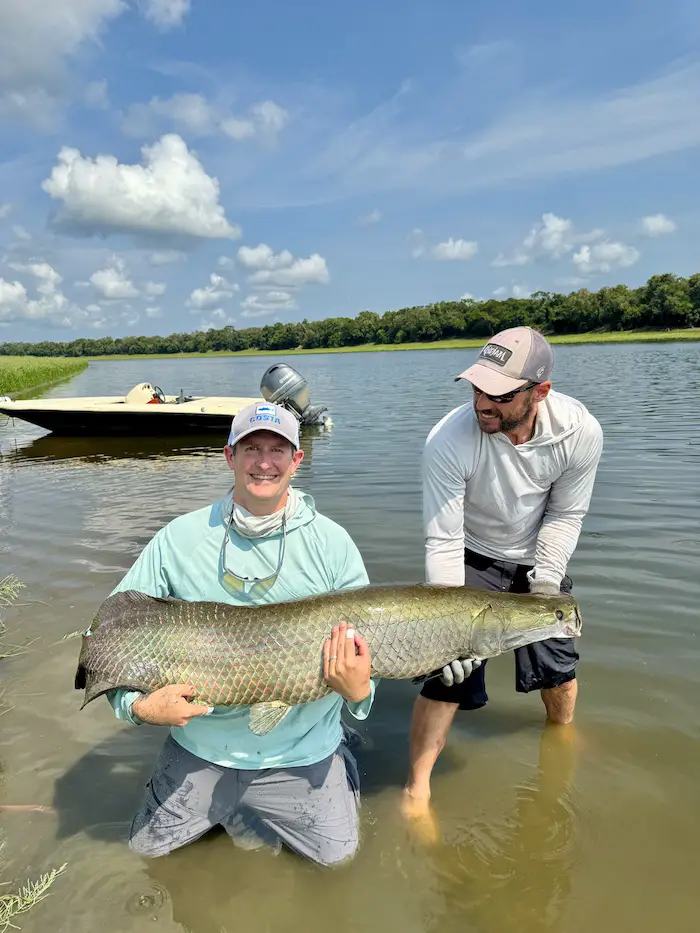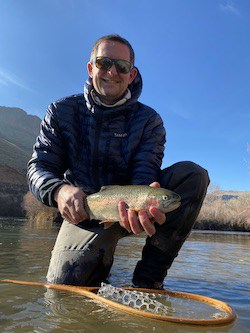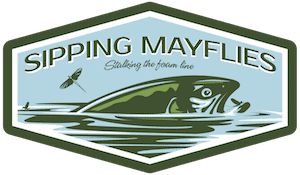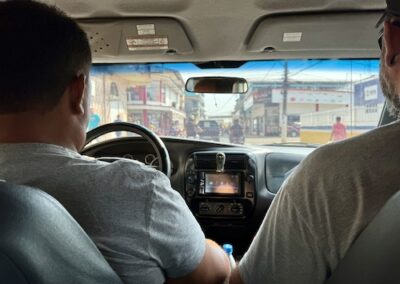Fly Fishing for Arapaima at Pirarucu Lodge
November 17th, 2024
Three weeks ago I returned from an adventurous trip to Pirarucu lodge in Brazil, where I spent four days fly fishing for arapaima. I’ve had time to process the entire experience, and I’m going to share my thoughts and takeaways with you below.
Specifically, I’ll explain how to get there, what to expect once you land, what the lodge and rooms look like, what gear to bring (and not bring) and of course all about the fishing, including which fly patterns worked the best.
Gear to Bring
Getting to Pirarucu Lodge
Exploring the Lodge
Fly Fishing for Arapaima
FAQs
Summary

Here’s an arapaima I caught on the fly while staying at Pirarucu lodge in Brazil. This particular fish was 5-feet 7-inches long (170cm). It was quite an adrenaline rush landing this jungle dweller!
Gear to Bring
I’m not going to cover every item you’ll want to pack, since there are detailed checklists available on the Pirarucu lodge website you can reference. You can find the checklist, along with other invaluable information on their website’s travel planner page. Don’t miss it.
Their checklists, coupled with my own research, equipped me extremely well. There was nothing I wished I’d brought but didn’t, other than an extra pair of clothes for dinner. Literally, that’s it.
Pirarucu lodge has an excellent laundry service, so you don’t need to bring a lot of clothing. It can take up to two days to get your laundry back, so plan accordingly.
I did overpack though. Specifically, I brought quite a few snacks, none of which I ate. The lodge keeps you well fed at breakfast, lunch, and dinner.
Fly Fishing gear
Their website recommends a 6-8 weight setup with floating line for targeting arowana, tambaqui, peacock bass, and other smaller jungle species. So, I brought my 7-weight Winston Alpha fly rod with Scientific Anglers Amplitude grand slam floating line. This setup worked flawlessly.
They also recommend bringing a 9-10 weight fly rod for “smaller” arapaima. So, I brought my Sage Salt 9-weight with intermediate sinking line. However, I never used this setup during the trip.
Finally, they recommend bringing a 12-weight setup for “giant” arapaima, rigged with 400-600 grain full sinking line, as well as one backup rod.
So, I brought my Sage Salt R8 (with extended fighting grip) coupled with Scientific Anglers 500 grain sonar titan big water taper max sink fly line. The reel I used was a Bauer RX7 with 300 yards of 30lb backing. I ended up absolutely loving this rod.
My backup 12-weight was my Scott Wave.
Leaders for jungle fish
I brought spools of 25lb, 40lb, 60lb, 80lb, and 100lb fluorocarbon line for the arapaima, but ended up only using the 80lb fluoro.
I used a straight 8-foot section of 20lb monofilament as the leader for my floating line setup (7-weight).
Arapaima flies
You’re going to use big streamers when you’re fly fishing for arapaima. I didn’t measure the patterns I used, but I’d say they were right around 7-inches in total length, including the tail attachment. My guide said it was like trying to cast a flag.
I was told I could buy flies at the lodge, but when I arrived, there were none available. So, bring some flies with you just in case.
Thankfully, I had purchased ten flies from an angler in Italy named Paolo Pacchiarini, along with a few Enrico Puglisi patterns from Fulling Mill’s website.
However, one pattern worked the best for me. It was the black-and-red streamer with a tail that I bought from Paolo. His black-and-purple pattern was also effective, but I always went back to black-and-red (pictured below).

How to Get to Pirarucu Lodge
Getting to Pirarucu lodge involves several airline flights, followed by a relatively short boat ride on the Amazon river.
Personally, I took five flights to get there. But, I live in Idaho. If you live near a major airport, it won’t take you as long.
The bottom line is, you need to get to Manaus, Brazil.
Manaus is the launching pad for almost all Brazilian fishing expeditions. The good news is, once you arrive in Manaus, it’s just a quick one hour flight to Tefe which is where you get onto the boat.
Flight Options
At the time of this writing, there are two basic ways of getting to Manaus from the United States.
You can either fly out of Miami direct to Manaus, or you can fly into Panama City, Panama, from various airports within the U.S. (such as Houston, San Francisco, etc).
I flew through Panama City because it was a better logistical choice for me. Once you arrive in Panama City, you’ll take a Copa Airlines flight to Manaus, and will land very early in the morning–I landed at 3am.
If you fly out of Miami, you’ll book through Azul airlines (started by the founder of Jet Blue) and will also land at around 3am in Manaus.
Your flight from Manaus to the city of Tefe will be via Azul airlines. Pay attention to the scheduled plane–depending upon the day of week, you will either be on a smaller propeller plane, or a large passenger jet. The propeller plane is a much longer flight, while the jet arrives an hour after takeoff.
Pro tip: If at all possible, plan on arriving a day early in Manaus. The reason is, if your flight is delayed getting into Manaus, you may miss your Azul flight to Tefe, and thus lose a day of fishing. The flight to Tefe leaves in the morning–my flight was at 7:30am.
Customs
You will not have to go through customs or re-check your luggage in Panama City on your way down to Brazil. However, you will have to collect and re-check your luggage in Panama City (and go through customs) on your way back to the U.S.
Once you land in Manaus and collect your luggage, an Untamed Angling (the company that owns Pirarucu lodge) representative will meet you in the main airport lobby. They will then drive you to the Juma Opera hotel and get you checked in at the front desk. The hotel is about 15 minutes from the airport.
The representative will also confirm with you the time they’ll pick you up and bring you back to the Manaus airport for your flight to Tefe.
The boutique hotel is excellent. The rooms are clean and up-to-date, there’s a rooftop pool, and the hotel restaurant is very good. I highly recommend the steak with fries. Here’s a fun fact: President Teddy Roosevelt stayed at the Juma Opera hotel after his incredible river adventure that you can read about in River of Doubt. (I’ve read it twice and highly recommend it.)
Here are a few pictures showing the Juma Opera hotel restaurant, bottled sparkling water, the delicious steak and fries, and the rooftop pool.
Once you’re checked in at the Manaus airport the next morning, grab some coffee and prepare for your flight to Tefe.
I really enjoyed this short flight, since you can see various Amazon tributaries out your window, along with jungle so dense that it almost seems like you’re looking at the ocean.
Once you land in Tefe, you’ll collect your luggage and walk into the lobby where an Untamed Angling representative will be watching for you. In my case, it was the head guide, Rafael Costa. He’s well known for always wearing an AC/DC hat, which is how I spotted him immediately. Rafael is the big kahuna at Pirarucu lodge, and a great guy.
You’ll hop into a vehicle and be driven to the docks where you’ll board a comfortable boat for the 1-2 hour (depending upon water levels) trip to the lodge.
Here are a few pictures of me waiting at the Manaus airport for my Azul airlines flight to Tefe, a picture from the plane, a picture showing the short drive through Tefe to the docks, and a shot of the Amazon boat ride heading to Pirarucu lodge.
Exploring Pirarucu Lodge
Finally arriving at Pirarucu lodge was surreal for me. All my planning and research had led up to this moment. It’d been a long trip already, but the adventure was actually just beginning!
The lodge itself floats, which makes sense considering the river water levels can change by several feet week-to-week. It’s anchored by thick ropes secured to the nearby shoreline.
In the water around the lodge, arowana, oscars, and rolling arapaima are ever-present. But, before you get too excited, it’s important to mention that fishing isn’t allowed at the actual lodge. Instead, you take a boat to the fishing grounds twice each day.
Meals and drinks at Pirarucu lodge
It was lunchtime when I arrived, so I was ushered straight to the main lodge for a hot meal. Four fly anglers were coincidentally arriving back at the lodge from their morning session, and they all immediately found me and introduced themselves.
They were a great group of guys and we ended up sharing every meal together. Conversation generally centered around the day’s fishing exploits, and past fishing adventures. We forged friendships and have kept in touch.
The food at Pirarucu lodge was quite good, and they always offered a variety of options.
Coffee is ready each morning at 5:30am, and breakfast is served at 6:30am. You have options for breakfast, but I generally ordered the scrambled eggs, which always hit the spot.
One of my favorite early morning rituals was drinking coffee on the lodge patio while watching (and listening to) the surrounding nature. You can always spot caiman, various birds, and fish. My favorite sound was when the howler monkeys would get fired up. If you’ve never heard a howler monkey’s eerie roar, do an online search and give it a listen.

Purified water is always available in the main lodge.
Lunch is served once you return from your morning fishing session (right around 12pm), cocktails and appetizers are served when you return from your afternoon fishing session (right around 6:30pm), and dinner is served at 7:30pm.
Lunch and dinner generally included chicken, fish, rice, beans, and vegetables all served buffet style. Dessert was always made available, as well as beer, wine, and mixed drinks, all included in the fishing package.
The lodge host was always extremely attentive and professional.
My favorite meal was the kung pao chicken with rice.
Inside a Pirarucu lodge room
I paid extra for a single occupancy room, but each room does have two beds and can sleep two anglers.
The room itself was a pleasant surprise, a clean jungle outpost with excellent amenities.
When you go to bed, you’ll be serenaded by caiman attacking prey, arapaima inhaling swarms of minnows (it sounds like a cherry bomb exploding 12-inches under the surface), and birds calling. It’s all part of the amazing adventure!
Below you’ll find three videos.
The first video shows the inside of my room at the lodge. Each room has electrical plugs (don’t forget your adapter), wifi, fans, mosquito-netting over the bed, a clean bathroom (with shower), and a comfortable deck. There’s no air conditioning, but they may add it in the future.
The second video is of a big caiman that was patrolling just outside my room. They’re everywhere!
The third video shows a huge caiman attacking and eating an egret right outside my room. Serendipitous timing! This video was quite popular at lunch with the other guests.
The entire lodge is clean and expertly run, yet you feel that you’re in the jungle, so you really get the best of both worlds.
The lodge is limited to eight anglers per week, so it’s never crowded and there’s a definite feeling of camaraderie. You can only fish during the dry season, the months of which are September, October, and November.
I mentioned earlier that I upgraded to a single occupancy room (people who snore keep me awake all night), but I also booked a single-angler skiff (by default there are two anglers per skiff). These are both upgrades you may consider when you plan your trip.
Fly Fishing for Arapaima at Pirarucu Lodge
Every morning after coffee and breakfast, a boat would arrive promptly to transport us to the fishing grounds which are about 15 minutes away.
On the way, there were small monkeys along the shoreline, innumerable birds, and huge numbers of caiman. It’s a ride I always looked forward to each day!
Speaking of that, each day is split up into two sessions, morning and afternoon. There’s a 2.5 hour break back at the lodge between the two outings, when you can eat lunch, relax, and enjoy an adult beverage.
Fly fishing for arapaima takes place in what looks like a narrow lake. In reality, it’s simply a very wide section of the Jayapura river.
If I had to guess, I’d say it’s about four miles long, and maybe a quarter-mile wide. It really depends upon the water levels—lower water means the lake is smaller, while higher water expands the fishable areas.
Once we arrived at the fishing grounds, we anglers would board our respective skiffs along with our primary guide, and a native guide.
The entire area is actually an arapaima fishing preserve, made possible by an agreement with the Brazilian government and the local native community. As such, the native people participate in the guiding and are very good at spotting a tambaqui rise ring, which can occur anywhere at any time.
I was guided first by Rafael, and then Guilherme. Often times the guides rotate, but not always. Both men have vast experience fly fishing for arapaima and are excellent guides—I also enjoyed their company off the water. The entire team at Pirarucu lodge is top notch.
The arapaima fly fishing method
If I were to describe how you fish for arapaima here, I’d call it dredging the bottom.
Equipped with my Sage Salt R8, and Scientific Anglers Sonar Titan 100lb core 500-grain full sinking line, I began casting the big streamer I showed you a picture of earlier.
My instructions were to cast as far as I could, let my fly sink to the bottom, and then start stripping very slowly. The water depth where we fished ranged from 15-20 feet or thereabouts.

Here’s a smaller arapaima (Arapaima gigas) I landed during my first morning session. It measured 4-feet seven inches (140cm).

Here’s a celebratory picture after landing my first arapaima.
Fly fishing for arapaima is a numbers game–that’s what I was told by my guides. In other words, you just have to get your reps in. Once you cast and strip your fly in, you cast again immediately.
Even though arapaima will be rolling (ie. rolling at the surface) frequently, this isn’t sight-fishing. You’re trying to catch arapaima on the bottom of the lake where they congregate.
Now, if you see an arapaima roll near the boat, it’s worth casting towards the fish. In fact, I hooked into one doing just that. But, their rolls are unpredictable and you can’t rely solely upon casting to rises.
By the way, the reason these amazing fish come to the surface is to swallow air–they do it about every 20 minutes. While they of course have functioning gills, they also have an air bladder that acts as a type of primitive lung with which they can extract oxygen from air as well. These are incredible fish.
Detecting a take
All but one of the arapaima I hooked into had identical takes.
The way I would describe it is to imagine a large fish swimming slowly, inhaling your fly, and continuing to swim away slowly.
This is when you want solidly strip set repeatedly (3-4 times).
Once the fish realizes something is awry, it’ll bolt.
This is when you’ll feel a jolt of adrenaline coursing through your body!
Arapaima have bony mouths–even bonier than tarpon–and getting a solid hookset isn’t a given. A little luck helps.
These giant fish run powerfully, but they don’t run too far. They tend to jump at least once or twice, and when I say jump, I mean nearly entirely out of the water. It’s truly a sight to behold, and something an angler will never forget.
Once your guide knows you’ve got a good hookset, he’ll use the trolling motor to maneuver the boat towards the shoreline where you’ll jump out and finish landing your fish.

Successfully landing a big arapaima is nothing short of exhilirating!
After I landed the arapaima pictured above, cleaned off with river water, and got back into the boat, I told Guilherme that my hands were still shaking from adrenaline. He smiled and said, “So are mine.”
In this picture, notice the reddish coloration on the tail. This is why arapaima are locally called “Pirarucu,” which literally means “red fish.”
There was one arapaima I hooked into that confused me initially.
I’d stripped my fly to within 30-feet of the boat and felt a modest thump. I instinctively performed a strip set, but missed the fish. I was convinced it was an arowana and told Guilherme as much.
But, I didn’t pull my line in to re-cast, I just kept slowly stripping. Within seconds a large arapaima took my fly the way I was accustomed to—much like being hooked-up to a slow-moving train.
While the huge fish threw my fly in mid-air about 30-seconds later, it was tremendously exciting nonetheless.
I owe this fish to the advice I received from Guilherme a couple days earlier. He said that if I felt a bite and missed it, keep stripping. The arapaima often come back for the fly.

Here’s an arowana I caught on a medium-sized streamer after just a few casts. This species is very acrobatic and fun to catch on the fly.
Arowana, peacock bass, piranha, and tambaqui
After I landed my biggest arapaima of the trip, I asked my guide how much time we had before we needed to head back to the lodge. He said around 30 minutes.
So, I said I wanted to spend the rest of the time casting for arowana, piranha, peacock bass, or whatever else might be hunting in the shallows.
This meant my guide positioned the boat so I could make long casts towards shoreline structure, mainly sunken trees.
Arowana are numerous and aggressive, so catching them isn’t too challenging. They can be caught on hoppers or streamers, whichever you prefer.
Peacock bass and piranha are less plentiful in this particular body of water, but you still may hook into one. I didn’t, however.
Tambaqui are a highly sought-after species at Pirarucu lodge, and your native guide will be scanning the water for their rises (as I mentioned previously). They’re similar to pacu, but can attain larger sizes. It’s not uncommon to get opportunities for them during your visit.
If a tambaqui rise is noticed, the guide will have you switch to your floating line setup and cast a slow-sinking berry fly pattern. This generally ensures a tambaqui hook-up. Unfortunately for me, as much as I wanted to catch one, my native guide never saw any of their rises during the four-days I fished there. I would even remind him occasionally by saying with a smile, “Tambaqui por favor!”

Here’s the impressive arapaima skull that’ll greet you when you arrive at Pirarucu lodge.
Pirarucu Lodge FAQs
Are there a lot of bugs?
There are surprisingly few. I don’t recall ever being harassed by mosquitos, ants, or anything else. Bring some bug spray that’s at least 25% deet just to be safe. With that said, I never even used mine.
Do I need an outlet adapter?
Yes, you can get the same one I used here.
Should I check my fishing gear as luggage?
This is a personal decision.
I checked one larger duffel that contained clothes and miscellaneous items, and carried-on my rods, fly lines, and leaders in this Simms travel case. Yes, it fits in the overhead bin nicely. I also wore a backpack full of important fishing-related items including all my reels.
What would I have done if security or a gate agent said I couldn’t bring my rod case onto the plane? I had a plan.
I would have taken my most important rod out of the case (specifically, my primary 12-weight setup) to carry onto the plane as a personal item, and would have then checked the case.
(For what it’s worth, on the long trip back I checked all my luggage except the backpack and everything arrived safely and on time.)
If for some reason you check your fishing gear and the airlines lose or delay your baggage, Pirarucu lodge has fly rods, reels, lines, and leaders that you can use.
Do I need a visa to enter Brazil?
This rule changes, so check Brazil’s Ministry of the Exterior website to learn if you’ll need a visa. I needed one, and it’s an easy process. You fill out their forms online, submit an electronic copy of your passport, and they e-mail you your visa a week or two later. Bring three copies with you on your trip.
Also make sure your passport won’t expire within six months of your travel to Brazil.
Do I need the yellow fever vaccine?
No, as of the date of this article Brazil doesn’t require the yellow fever vaccine for entry into the country. But, do your own research since this may change. Here are two reasons why I got it.
Firstly, the yellow fever vaccine is a one-and-done lifetime vaccine, meaning once you get it, you’re covered for the rest of your life. It’s also a live vaccine with a long track record.
Secondly, at last count, 20 African countries require the yellow fever vaccine (Cameroon, Gabon, Congo, to name a few), as do some South American countries. Since I plan on traveling to some of these countries in the future, I figured I may as well get it over with now.
Summary
My entire experience fly fishing at Pirarucu lodge was nothing short of spectacular!
The lodge is clean, comfortable, extremely well run, and has the exotic feel of a jungle outpost.
The fly fishing guides are highly experienced (some have been with the lodge for nine years) and will get you into arapaima, as well as other species.
Lastly, hooking into an arapaima is an absolutely electric feeling, and landing one is indescribable. It’s a memory I’ll always cherish.
If you have the means and the time, I highly recommend a visit to Pirarucu lodge.

About the Author
My name's Sam and I'm a fly fishing enthusiast just like you. I get out onto the water 80+ times each year, whether it's blazing hot or snow is falling. I enjoy chasing everything from brown trout to snook, and exploring new waters is something I savor. My goal is to discover something new each time I hit the water. Along those lines, I record everything I learn in my fly fishing journal so I can share it with you.
Follow me on Instagram , YouTube, and Facebook to see pictures and videos of my catches and other fishing adventures!










